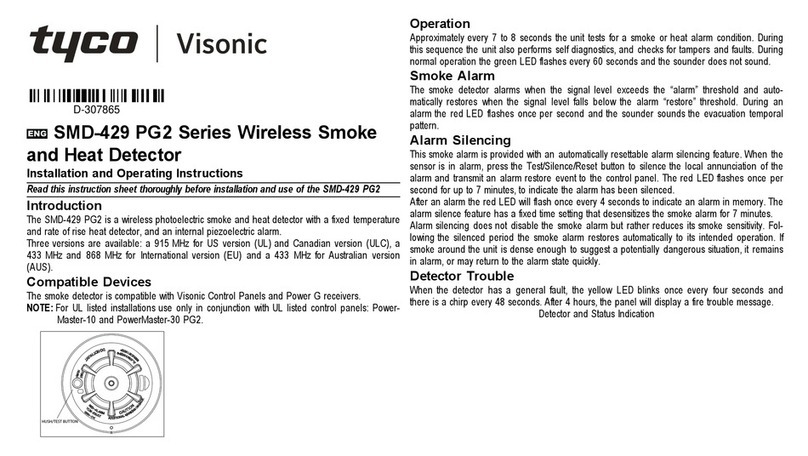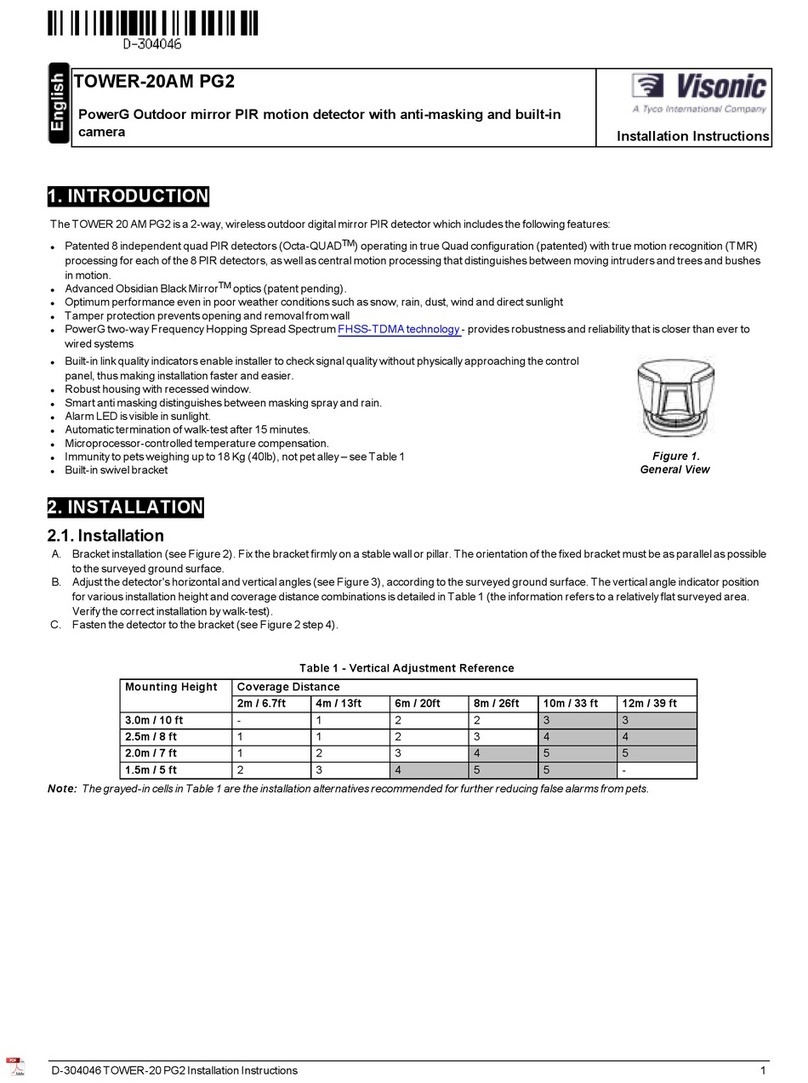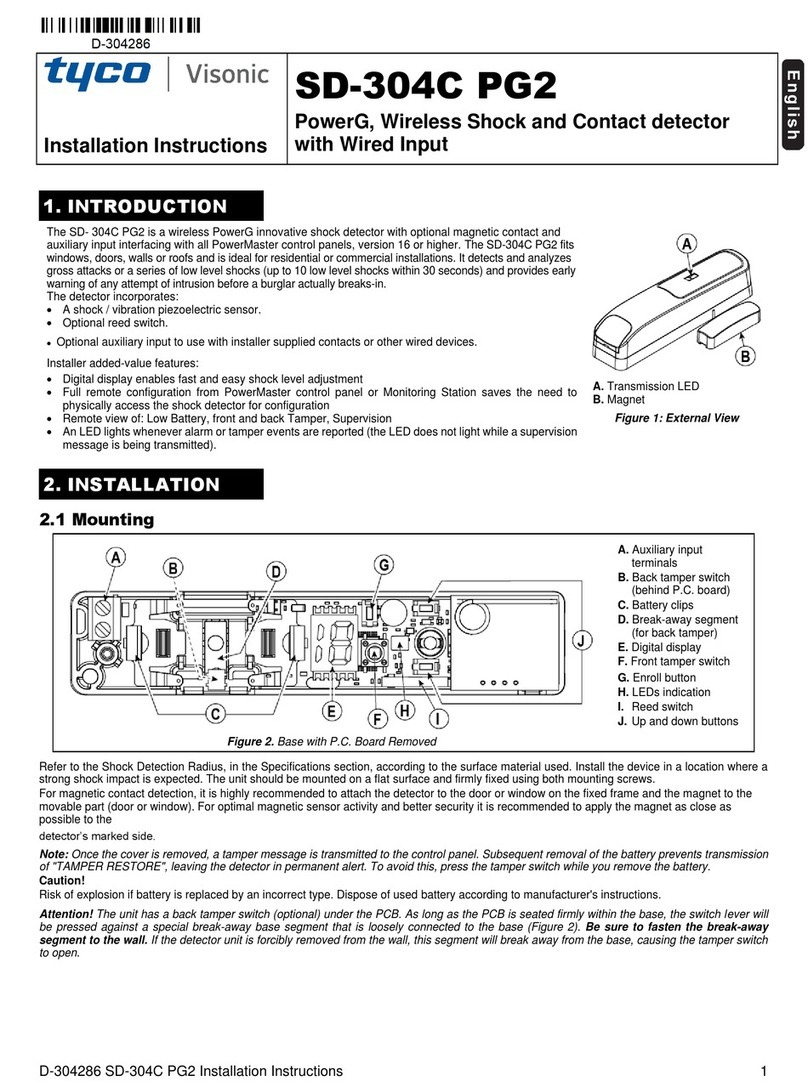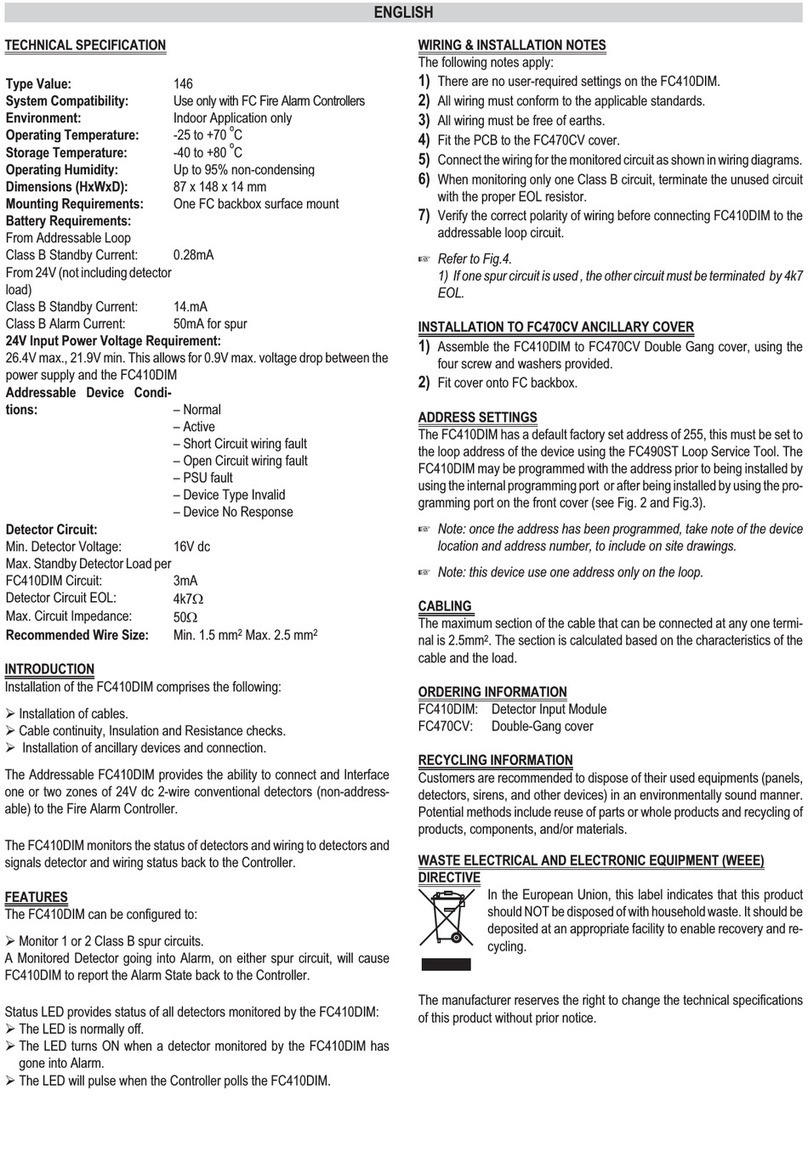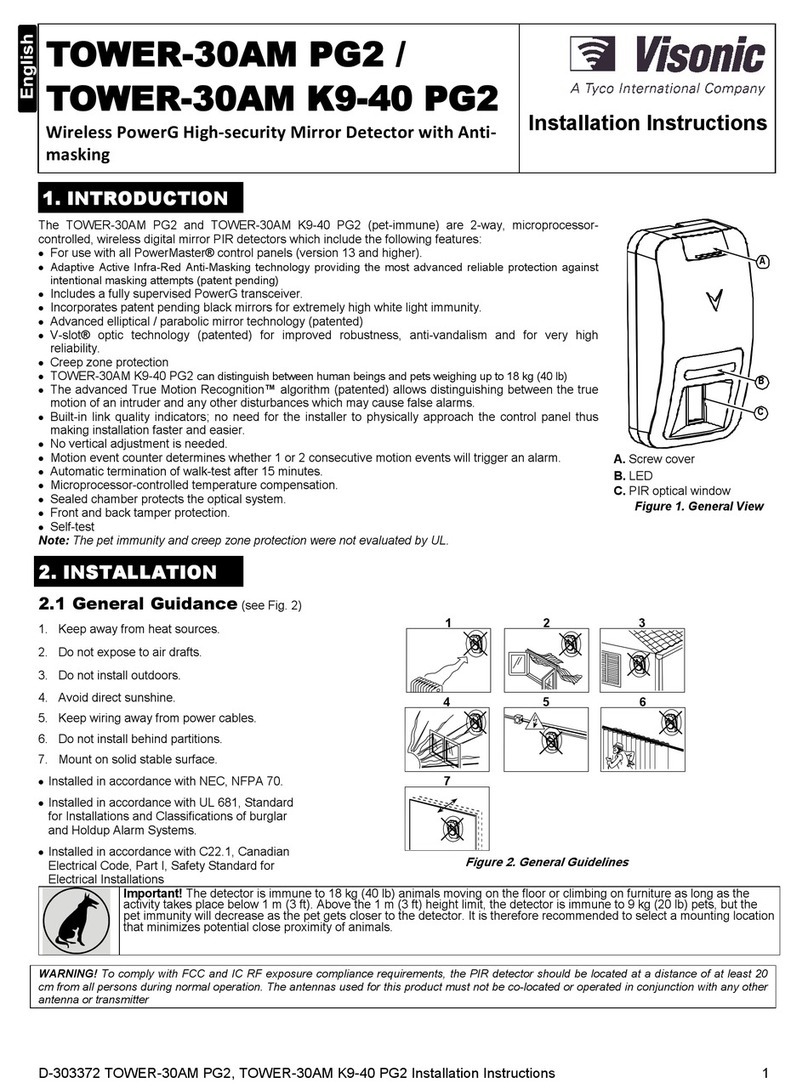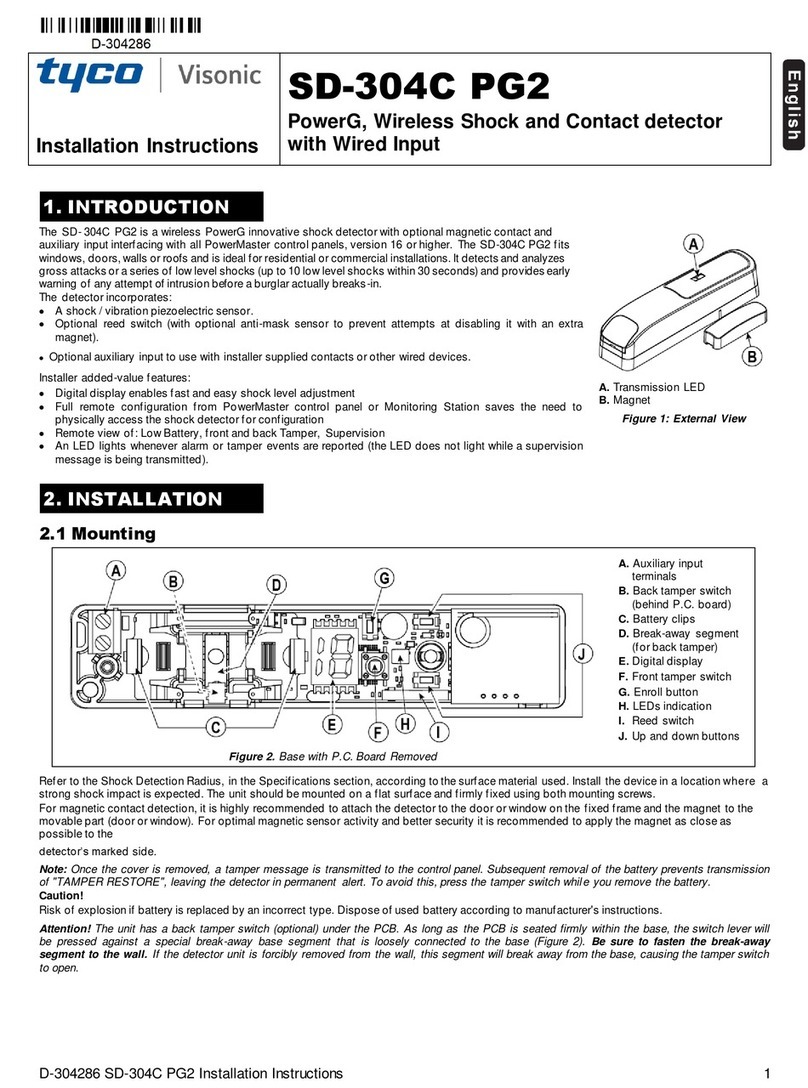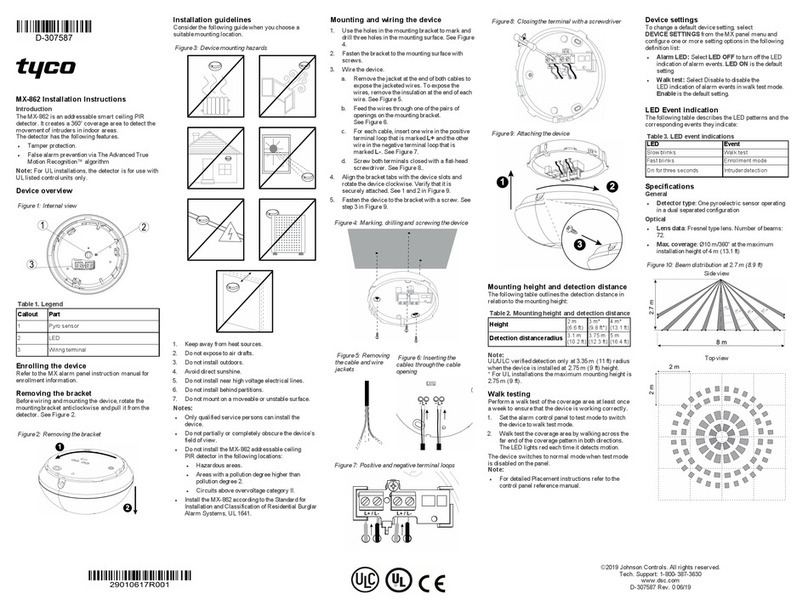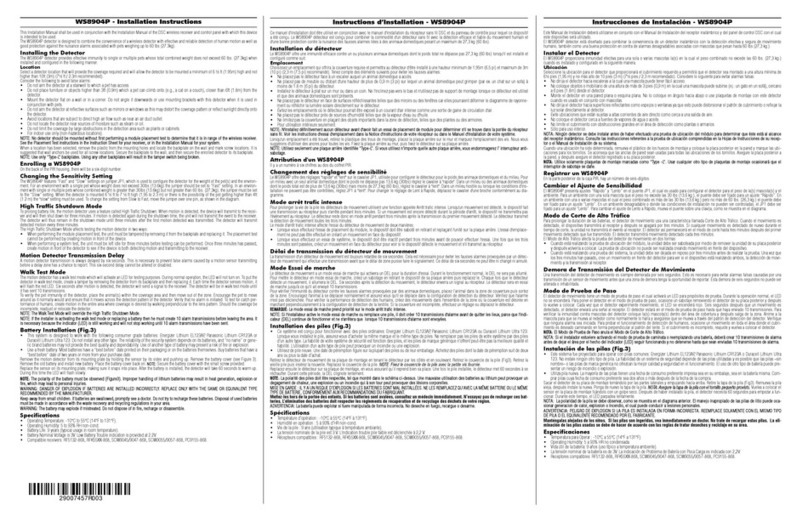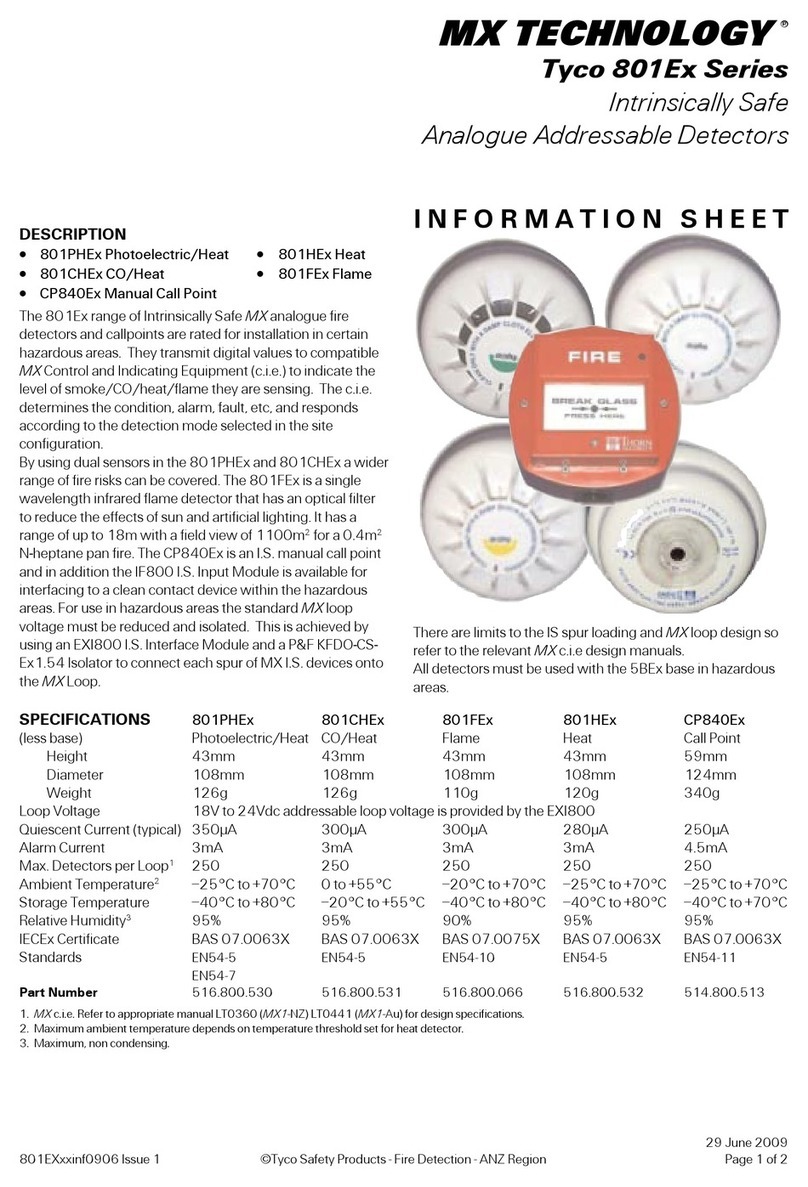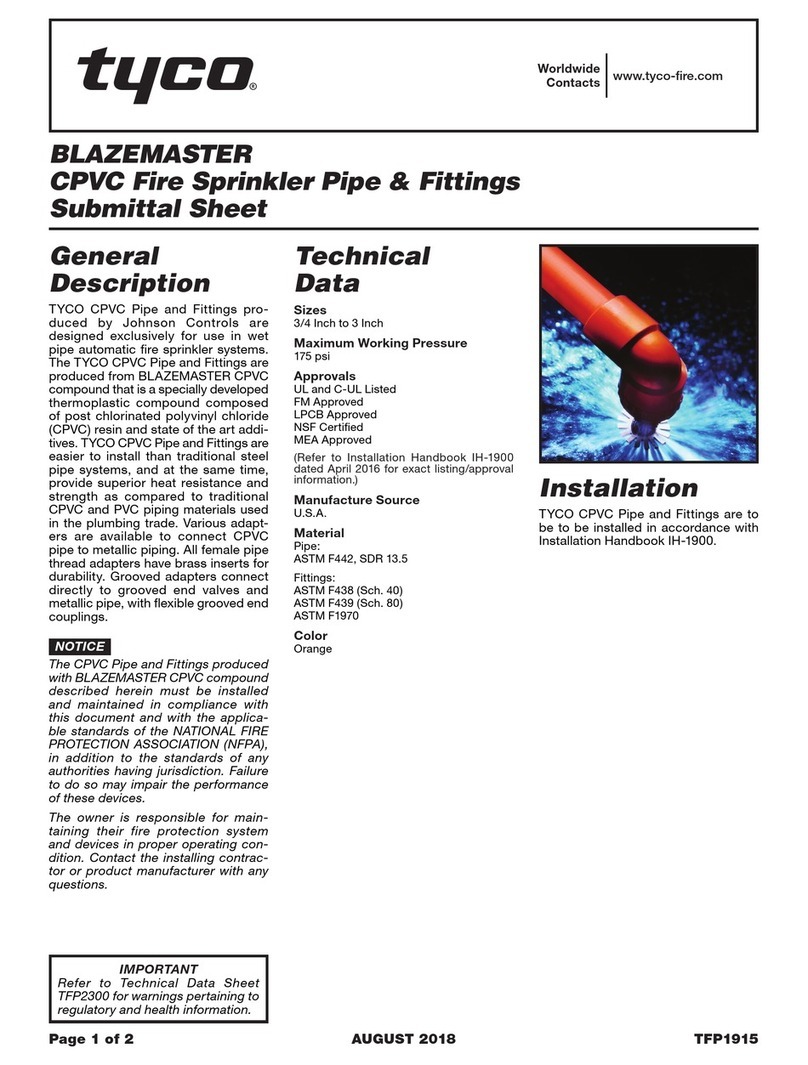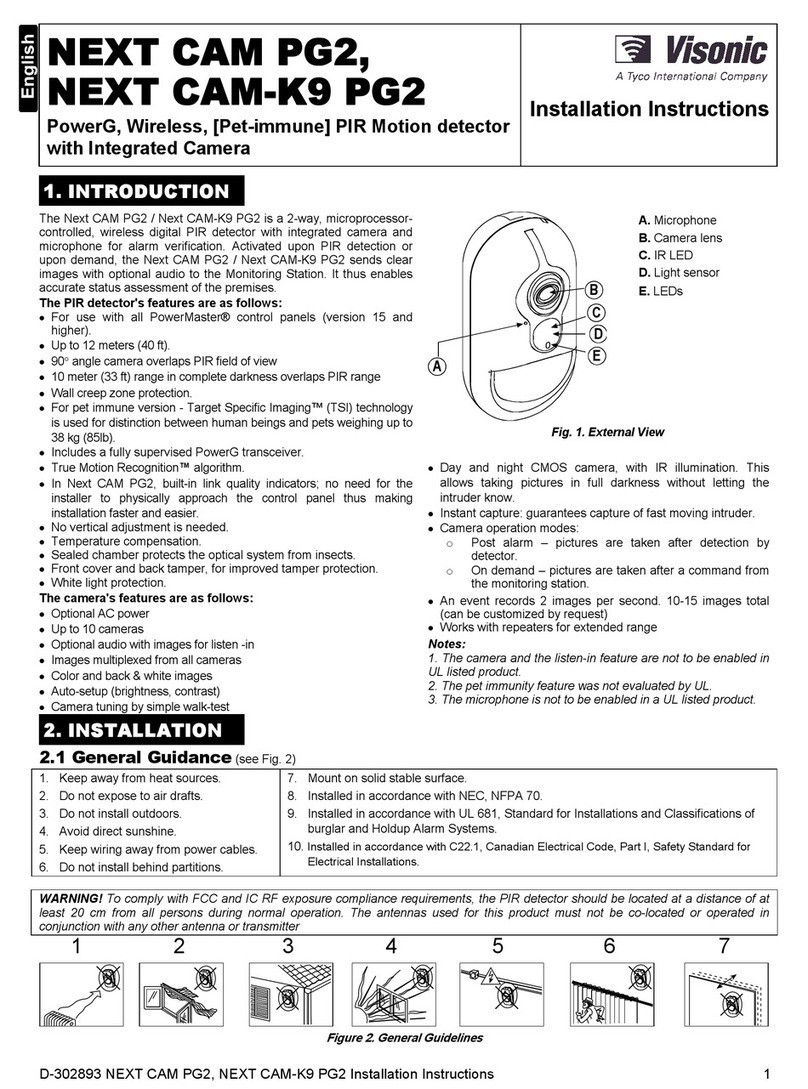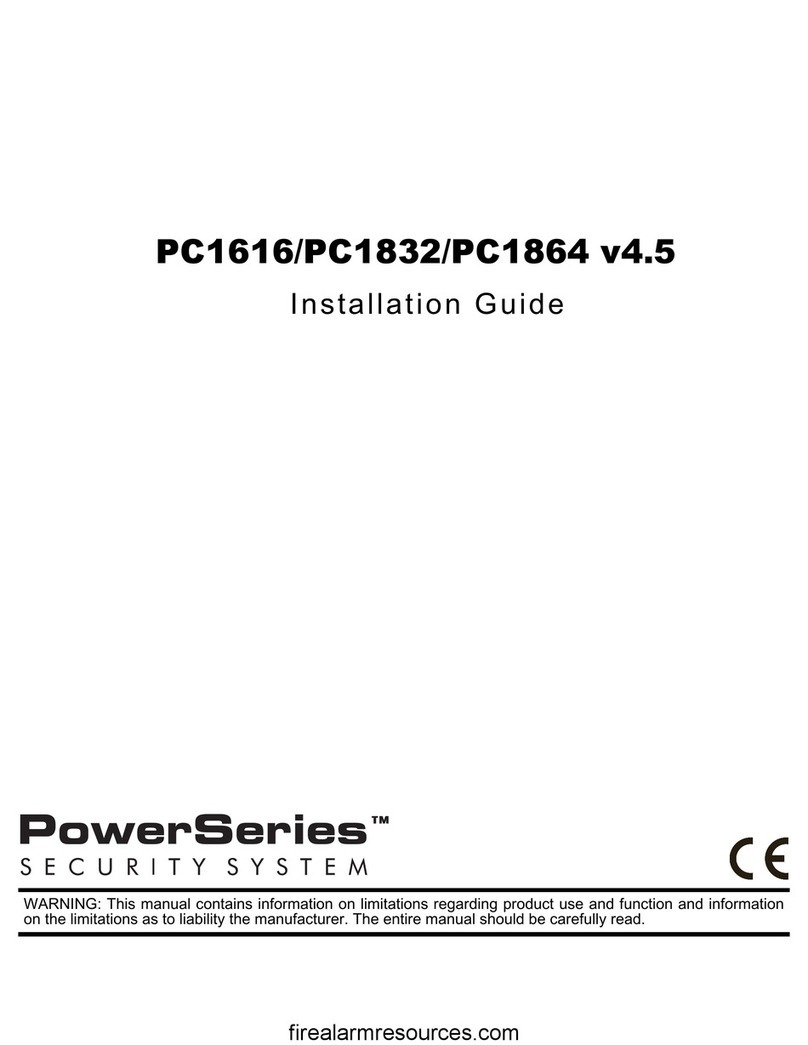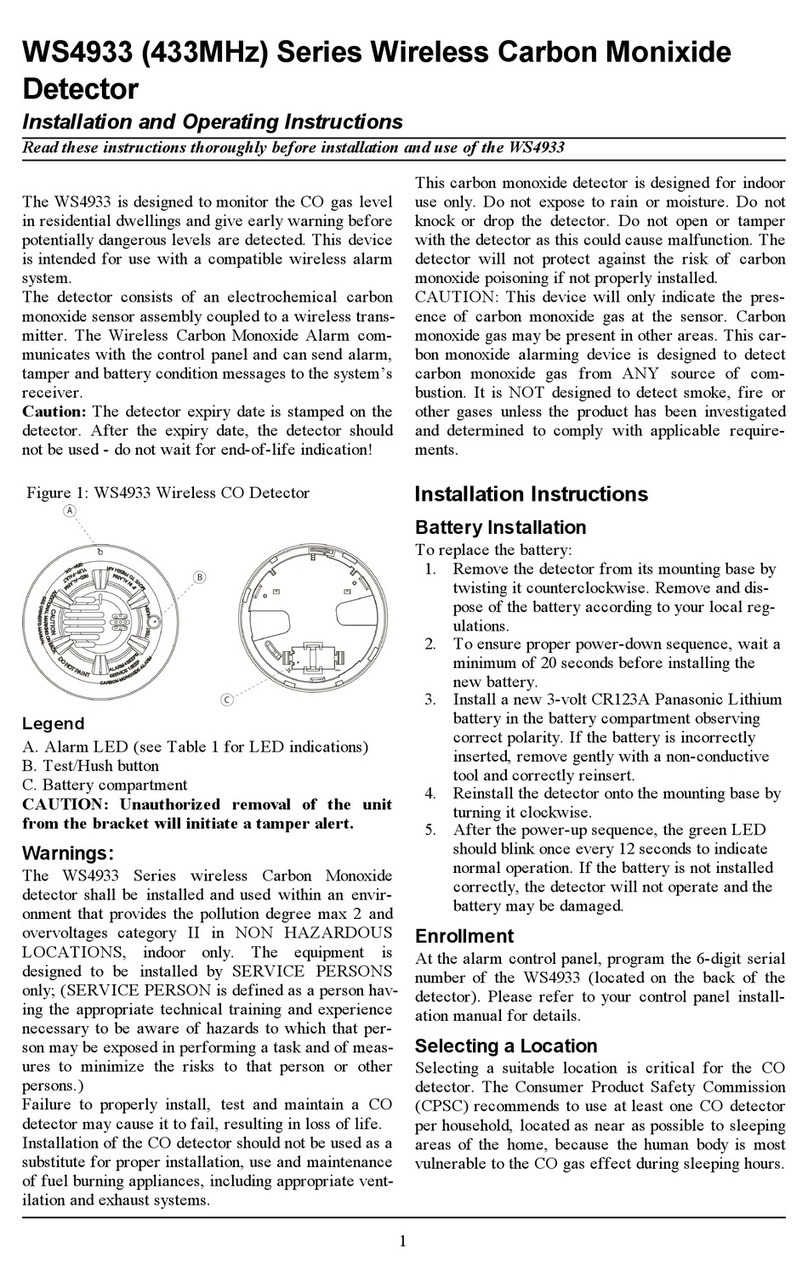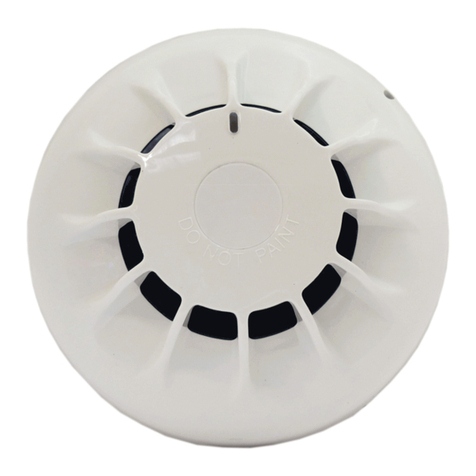
Heat Detectors: Heat detectors that are a part of this system may not properly alert occupants of a fire for a number of reas-
ons, some of which follow. The Heat detectors may have been improperly installed or positioned. Heat may not be able to
reach the heat detectors, such as when the fire is in a chimney, walls or roofs, or on the other side of closed doors. Heat
detectors may not detect heat from fires on another level of the residence or building.
Every fire is different in the amount of heat produced and the rate of burning. Heat detectors cannot sense all types of fires
equally well. Heat detectors may not provide timely warning of fires caused by carelessness or safety hazards such as smoking
in bed, violent explosions, escaping gas, improper storage of flammable materials, overloaded electrical circuits, children play-
ing with matches or arson.
Even if the Heat detector operates as intended, there may be circumstances when there is insufficient warning to allow all
occupants to escape in time to avoid injury or death.
Warning: Digital Security Controls recommends that the entire system be completely tested on a regular basis. However, des-
pite frequent testing, and due to, but not limited to, criminal tampering or electrical disruption, it is possible for this product to
fail to perform as expected.
Important Information: Changes or modifications not expressly approved by Digital Security Controls could void the user’s
authority to operate this equipment.
EULA
IMPORTANT - READ CAREFULLY: DSC Software purchased with or without Products and Components is copy-
righted and is purchased under the following license terms:
This End-User License Agreement (“EULA”) is a legal agreement between You (the company, individual or entity who
acquired the Software and any related Hardware) and Digital Security Controls, a division of Tyco Safety Products Canada
Ltd. (“DSC”), the manufacturer of the integrated security systems and the developer of the software and any related
products or components (“HARDWARE”) which You acquired. If the DSC software product (“SOFTWARE PRODUCT” or
“SOFTWARE”) is intended to be accompanied by HARDWARE, and is NOT accompanied by new HARDWARE, You may not
use, copy or install the SOFTWARE PRODUCT. The SOFTWARE PRODUCT includes computer software, and may include
associated media, printed materials, and “online” or electronic documentation. Any software provided along with the
SOFTWARE PRODUCT that is associated with a separate end-user license agreement is licensed to You under the terms of
that license agreement. By installing, copying, downloading, storing, accessing or otherwise using the SOFTWARE
PRODUCT, You agree unconditionally to be bound by the terms of this EULA, even if this EULA is deemed to be a modi-
fication of any previous arrangement or contract. If You do not agree to the terms of this EULA, DSC is unwilling to license
the SOFTWARE PRODUCT to You, and You have no right to use it.
SOFTWARE PRODUCT LICENSE
The SOFTWARE PRODUCT is protected by copyright laws and international copyright treaties, as well as other intellectual
property laws and treaties. The SOFTWARE PRODUCT is licensed, not sold.
GRANT OF LICENSE This EULA grants You the following rights:
Software Installation and Use - For each license You acquire, You may have only one copy of the SOFTWARE PRODUCT
installed.
Storage/Network Use - The SOFTWARE PRODUCT may not be installed, accessed, displayed, run, shared or used con-
currently on or from different computers, including a workstation, terminal or other digital electronic device (“Device”). In other
words, if You have several workstations, You will have to acquire a license for each workstation where the SOFTWARE will be
used.
Backup Copy - You may make back-up copies of the SOFTWARE PRODUCT, but You may only have one copy per license
installed at any given time. You may use the back-up copy solely for archival purposes. Except as expressly provided in this
EULA, You may not otherwise make copies of the SOFTWARE PRODUCT, including the printed materials accompanying the
SOFTWARE.
DESCRIPTION OF OTHER RIGHTS AND LIMITATIONS
Limitations on Reverse Engineering, Decompilation and Disassembly - You may not reverse engineer, decompile, or
disassemble the SOFTWARE PRODUCT, except and only to the extent that such activity is expressly permitted by applicable
law notwithstanding this limitation. You may not make any changes or modifications to the Software, without the written per-
mission of an officer of DSC. You may not remove any proprietary notices, marks or labels from the Software Product. You
shall institute reasonable measures to ensure compliance with the terms and conditions of this EULA.
Separation of Components - The SOFTWARE PRODUCT is licensed as a single product. Its component parts may not be
separated for use on more than one HARDWARE unit.
Single INTEGRATED PRODUCT - If You acquired this SOFTWARE with HARDWARE, then the SOFTWARE PRODUCT is
licensed with the HARDWARE as a single integrated product. In this case, the SOFTWARE PRODUCT may only be used with
the HARDWARE as set forth in this EULA.
Rental - You may not rent, lease or lend the SOFTWARE PRODUCT. You may not make it available to others or post it on a
server or web site.
Software Product Transfer - You may transfer all of Your rights under this EULA only as part of a permanent sale or trans-
fer of the HARDWARE, provided You retain no copies, You transfer all of the SOFTWARE PRODUCT (including all com-
ponent parts, the media and printed materials, any upgrades and this EULA), and provided the recipient agrees to the terms
of this EULA. If the SOFTWARE PRODUCT is an upgrade, any transfer must also include all prior versions of the SOFTWARE
PRODUCT.
Termination - Without prejudice to any other rights, DSC may terminate this EULA if You fail to comply with the terms and
conditions of this EULA. In such event, You must destroy all copies of the SOFTWARE PRODUCT and all of its component
parts.
Trademarks - This EULA does not grant You any rights in connection with any trademarks or service marks of DSC or its sup-
pliers.
COPYRIGHT - All title and intellectual property rights in and to the SOFTWARE PRODUCT (including but not limited to any
images, photographs, and text incorporated into the SOFTWARE PRODUCT), the accompanying printed materials, and any
copies of the SOFTWARE PRODUCT, are owned by DSC or its suppliers. You may not copy the printed materials accom-
panying the SOFTWARE PRODUCT. All title and intellectual property rights in and to the content which may be accessed
through use of the SOFTWARE PRODUCT are the property of the respective content owner and may be protected by applic-
able copyright or other intellectual property laws and treaties. This EULA grants You no rights to use such content. All rights
not expressly granted under this EULA are reserved by DSC and its suppliers.
EXPORT RESTRICTIONS - You agree that You will not export or re-export the SOFTWARE PRODUCT to any country, per-
son, or entity subject to Canadian export restrictions.
CHOICE OF LAW - This Software License Agreement is governed by the laws of the Province of Ontario, Canada.
ARBITRATION - All disputes arising in connection with this Agreement shall be determined by final and binding arbitration in
accordance with the Arbitration Act, and the parties agree to be bound by the arbitrator’s decision. The place of arbitration
shall be Toronto, Canada, and the language of the arbitration shall be English.
LIMITED WARRANTY
NO WARRANTY - DSC PROVIDES THE SOFTWARE “AS IS” WITHOUT WARRANTY. DSC DOES NOT WARRANT THAT
THE SOFTWARE WILL MEET YOUR REQUIREMENTS OR THAT OPERATION OF THE SOFTWARE WILL BE
UNINTERRUPTED OR ERROR-FREE.
CHANGES IN OPERATING ENVIRONMENT - DSC shall not be responsible for problems caused by changes in the oper-
ating characteristics of the HARDWARE, or for problems in the interaction of the SOFTWARE PRODUCT with non-DSC-
SOFTWARE or HARDWARE PRODUCTS.
LIMITATION OF LIABILITY; WARRANTY REFLECTS ALLOCATION OF RISK - IN ANY EVENT, IF ANY STATUTE
IMPLIES WARRANTIES OR CONDITIONS NOT STATED IN THIS LICENSE AGREEMENT, DSC’S ENTIRE LIABILITY UNDER
ANY PROVISION OF THIS LICENSE AGREEMENT SHALL BE LIMITED TO THE GREATER OF THE AMOUNT ACTUALLY
PAID BY YOU TO LICENSE THE SOFTWARE PRODUCT AND FIVE CANADIAN DOLLARS (CAD$5.00). BECAUSE SOME
JURISDICTIONS DO NOT ALLOW THE EXCLUSION OR LIMITATION OF LIABILITY FOR CONSEQUENTIAL OR
INCIDENTAL DAMAGES, THE ABOVE LIMITATION MAY NOT APPLY TO YOU.
DISCLAIMER OF WARRANTIES - THIS WARRANTY CONTAINS THE ENTIRE WARRANTY AND SHALL BE IN LIEU OF
ANY AND ALL OTHER WARRANTIES, WHETHER EXPRESSED OR IMPLIED (INCLUDING ALL IMPLIED WARRANTIES OF
MERCHANTABILITY OR FITNESS FOR A PARTICULAR PURPOSE) AND OF ALL OTHER OBLIGATIONS OR LIABILITIES ON
THE PART OF DSC. DSC MAKES NO OTHER WARRANTIES. DSC NEITHER ASSUMES NOR AUTHORIZES ANY OTHER
